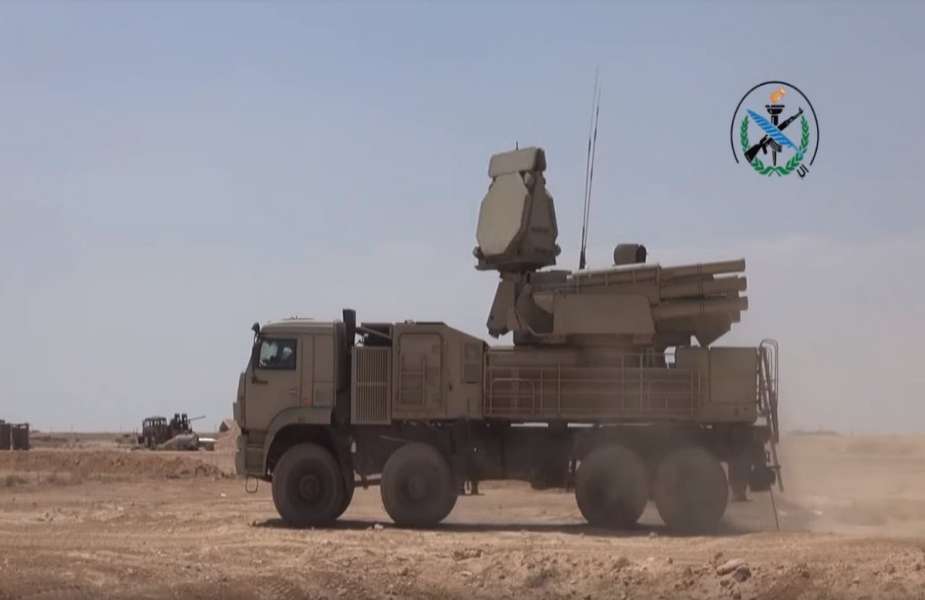Breaking news
Open Source reveals Syria is supplying Hezbollah with Russian Pantsir S1 Air Defense System.
On December 15, 2023, Al-Askary Media, affiliated with Hayat Tahrir Al-Sham based in Idlib, released a series of infographics on Telegram claiming that Russia had supplied the Lebanese Hezbollah with advanced air defense systems through the Wagner Group, in coordination with the Syrian regime. These allegations are based on a November 2 article from the Wall Street Journal, which discussed the possibility of Russia providing a Pantsir-S1 air defense system in response to escalating tensions on Lebanon's southern border.
Follow Army Recognition on Google News at this link

A Russian Pantsir S1, also known as SA-22 Greyhound, in Syria (Picture source: Syria MoD)
EKAD, an Arabic open-source intelligence platform, reportedly sought to verify this information by tracking the movement of weapons from Wagner-controlled areas to Syria. According to EKAD, a significant air bridge was established between Wagner sites in Benghazi, Libya, and the Shayrat military airport south of Homs in Syria, which is under Iranian control. An Ilyushin II-76 from the Wagner Air Fleet reportedly conducted eight flights between Benghazi and Shayrat from October 21 to 27, followed by a Syrian Airlines plane, linked to the Iranian Revolutionary Guard, which also reportedly made eight flights between these destinations starting November 22. A third plane, affiliated with Syrian Airlines and the Iranian Revolutionary Guard, supposedly carried out eight flights between Benghazi and Syria from October 16 to November 27, including six to Damascus Airport and two to Shayrat.
Shayrat Airport was reportedly chosen due to its proximity to the Syrian town of Qusayr, under Hezbollah control, and the Lebanese border crossing of 'Housh al-Sayyid Ali'. This route had been used by Hezbollah as a military supply line during the Battle of Qusayr in 2013.
In November 2023, several media outlets, including the Wall Street Journal and CNN, reported the likely delivery of Pantsir-S1 systems to Hezbollah by Russia via Wagner and in coordination with the Syrian regime, although these claims were denied by the Kremlin as reported by Reuters. This cooperation between Wagner, Syria, and Hezbollah was revealed in August by the Institute for the Study, indicating an intention to drive the United States out of the region.
From a technical standpoint, the Pantsir-S1 (NATO reporting name SA-22 Greyhound) is a Russian-made short to medium-range surface-to-air missile and anti-aircraft artillery weapon system. Designed to defend against a variety of threats including fixed-wing aircraft, helicopters, drones, and precision-guided munitions, the Pantsir-S1 has played a significant role in Russian military support to the Syrian government. It has been used to protect military and strategic locations in Syria.
The Pantsir-S1 combines surface-to-air missiles and anti-aircraft artillery, providing advanced defense against various aerial threats. It is equipped with 12 57E6 or 57E6-E surface-to-air missiles in sealed launch containers, with a range of approximately 20 kilometers and an altitude of up to 15 kilometers. It also includes two 2A38M 30 mm automatic cannons, effective up to 4 kilometers. The system can engage multiple targets simultaneously thanks to its phased-array radars, tracking up to 40 targets and engaging up to four at the same time. Its mobile design allows it to reposition quickly in response to threats, with rapid reaction times to detect, identify, and fire at a target.
The integration of the Pantsir S1 air defense system into Hezbollah's arsenal, while not radically altering the balance of power, represents a significant development that could complicate the Israeli military's freedom of maneuver at low altitudes along its northern border, particularly in the context of heightened tensions fueled by the Gaza crisis. The use of this system by Hezbollah could potentially limit the effectiveness of Israel's long-range drones and air-to-ground weapons, key elements of the IDF's strategy in this region. Beyond its tactical implications, the introduction of the Pantsir S1 symbolizes significant Russian support for Hezbollah and Iran, marking a significant shift in the geopolitical landscape and power dynamics vis-à-vis Israel. This development not only underscores an enhancement of Hezbollah's defensive capabilities but also extends Russian influence in the region, adding a new dimension to Israel's strategic calculations in managing its borders and regional security.


























